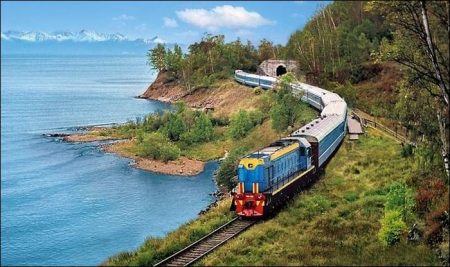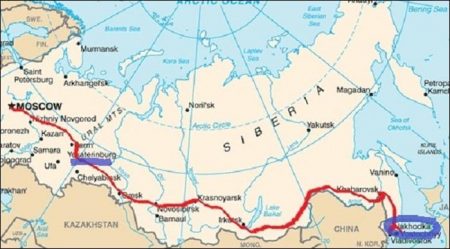The Trans-Siberian Railway or Trans-Siberian Railroad is a network of railways connecting Moscow and European Russia with the Russian Far East provinces, Mongolia, China and the Sea of Japan. It is the longest railway in the world. Today, the railway is part of the Eurasian Land Bridge.
Return tickets from Central Europe to Vladivostok and back can be as cheap as €250 with so called CityStar or Sparpreis Europa special offers. In addition, a reservation supplement for long-distance trains is mandatory, the prices range between €30 to €60 each way for trains in four-berth sleeper on the Trans-Siberian Railway. Overall, buying tickets for Russian trains in Germany, the Czech Republic or Poland can be cheaper than in Russia.
In addition to these services, a number of privately-chartered services are operated, and one tour operator even commissioned the construction of their own train, jointly owned by themselves and Russian railways. The train, officially named Golden Eagle Trans-Siberian Express was launched on 26 April 2007 by Prince Michael of Kent.
Route Stations
Yaroslavsky Terminal Moscow, Yaroslavl, Kirov, Perm, Yekaterinburg, Tyumen, Omsk, Novosibirsk, Krasnoyarsk, Taishet, Irkutsk, Ulan Ude, Chita, Trans-Manchurian Railway, Amur-Yakutsk Mainline, to Blagoveshchensk, Birobidzhan, Khabarovsk, Vladivostok.
Route Description
The Trans-Siberian Railway is often associated with the main transcontinental Russian line that connects hundreds of large and small cities of the European and Asian parts of Russia. At 9,289 kilometres (5,772 miles), spanning a record seven time zones[dated info] and taking eight days to complete the journey, it is the third-longest single continuous service in the world, after the Moscow–Pyongyang 10,267 kilometres (6,380 mi) and the Kiev–Vladivostok 11,085 kilometres (6,888 mi) services, both of which also follow the Trans-Siberian for much of their routes.
The main route of the Trans-Siberian Railway begins in Moscow at Yaroslavsky Vokzal, runs through Yaroslavl, Chelyabinsk, Omsk, Novosibirsk, Irkutsk, Ulan-Ude, Chita and Khabarovsk to Vladivostok via southern Siberia.
A second primary route is the Trans-Manchurian, which coincides with the Trans-Siberian east of Chita as far as Tarskaya (a stop 12 km (7 mi) east of Karymskoye, in Chita Oblast), about 1,000 km (621 mi) east of Lake Baikal. From Tarskaya the Trans-Manchurian heads southeast, via Harbin and Mudanjiang in China’s Northeastern Provinces (from where a connection to Beijing is used by one of the Moscow–Beijing trains), joining with the main route in Ussuriysk just north of Vladivostok.
This is the shortest and the oldest railway route to Vladivostok. While there are currently no traverse passenger services (enter China from one side and then exit China and return to Russia on the other side) on this branch, it is still used by several international passenger services between Russia and China.
The third primary route is the Trans-Mongolian Railway, which coincides with the Trans-Siberian as far as Ulan-Ude on Lake Baikal’s eastern shore. From Ulan-Ude the Trans-Mongolian heads south to Ulaan-Baatar before making its way southeast to Beijing.
In 1991, a fourth route running further to the north was finally completed, after more than five decades of sporadic work. Known as the Baikal Amur Mainline (BAM), this recent extension departs from the Trans-Siberian line at Taishet several hundred miles west of Lake Baikal and passes the lake at its northernmost extremity. It crosses the Amur River at Komsomolsk-na-Amure (north of Khabarovsk), and reaches the Tatar Strait of the Sea of Japan at Sovetskaya Gavan. On 13 October 2011 a train from Khasan made its inaugural run to Rajin in North Korea.
Visits: 180




